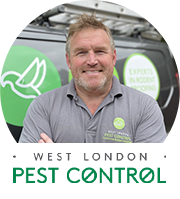West London Pest Control - Moth Control & Moth Treatments in West London
Depending on which newspaper you read, you may be aware that moth infestations are on the increase. For some experts, this is because as consumers, we are once again opting for organic and natural materials to not only wear but furnish our homes with. With moths, providing the fabric has more than 25% of a natural material such as wool or cotton, it will lays its eggs on it, as it will make the perfect food for the merging larvae.



NOT dangerous!
Moths, unlike other infestations, are not dangerous to human health although the holes left in clothing and soft furnishings, stored away, can be a tremendous nuisance. They do not bite nor sting, neither do they carry disease.
However, as with most infestations the signs can be similar between one insect and another; not identifying the right pest can lead to the wrong kind of treatment, rendering time, effort and money spent on rectifying the problem, useless. As with all possible infestations, getting in an expert pest controller to confirm the pest, and the treatment needed will save a lot of fuss and hassle in the long run.
Knowing a moth infestation
In most cases, noticing holes and the like in clothes and soft furnishings can be a sign of moths (but it can be carpet beetles too) but there are other tell-tale signs;
- If you think you have moths, then check wardrobes, chests, storage boxes, trunks anywhere in fact, that is dark and undisturbed. What you are looking for are larvae casings, as well as the moths themselves.
- Heavy moth infestations are when they fly out from a cupboard or other dark storage area, when it is opened and exposed to light
- Is it a spider’s web or webbing made by moths to house pupal cases? Some people notice what seem like a large amount of webs in the attic or storage area that have not been apparent before
- Small mounds of dust, known as frass, at the base of wooden items such as wardrobes and around the edges of trunks etc. are all tell-tale signs of moths (although woodworms also leave a similar trace of dust); this frass is the waste products are moths chew their way through items
- If you think you have moths in a room where there is upholstered furniture, it is always worth checking underneath these items too for any damage
Do moths only chew through natural materials and fabrics?
Many people think that because they do not have an abundance of natural fibres and fabrics within their home that they are not at risk of moth infestations. The truth is that there needs to be very little in the way of natural fibres within a material. It seems that any home can be the perfect place for a moth to lays its eggs.
Prevention better that cure
However, moth infestations can be easily prevented, a far cheaper option that treating a moth infestation, as well as replacing damaged items.
- Storing clothes should be done in airtight, plastic bags or containers
- Clothes and any other items to be stored should be clean and checked over before you place them in storage
- Checking items regularly for any tell-tale signs of moths can also stop an infestation in its tracks
- Moths also find a lot of nutrition in dust and dirt; not only should clothes and other items being store be clean but so should the receptacle being used for storing them
- Birds’ nests around the property – whether on the property or in close by trees – can also be sources of many an insect infestation within a home or business, including moths; expert pest controllers will automatically look for these when completing a pest control task!
- There are also prevention products that you can buy that claim to protect clothing and other stored items; the undeniable pungent smell of ‘moth balls’ were common in many a home in the earlier part of the 20th Century but have fallen out of fashion to a certain degree. There are other products on the market today and, used in conjunction with other methods, such as storing clean clothes etc., they won’t do any harm
- Regular and thorough vacuuming in parts of the home where such items are stored is essential too, paying particular attention to the dark corners and crevices that are easily missed by the vacuum
Advice and action on moths!
If you think you have moths – but are unsure – don’t waste time on treatments that could be treating the wrong thing! Contact us for a free, no obligation assessment today!







 for W areas
for W areas





